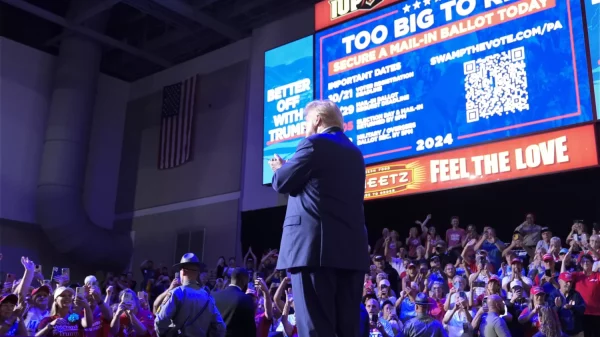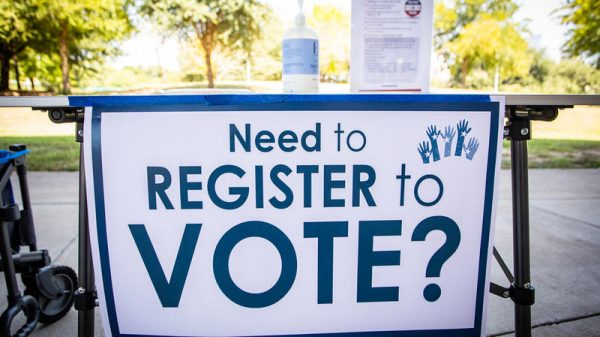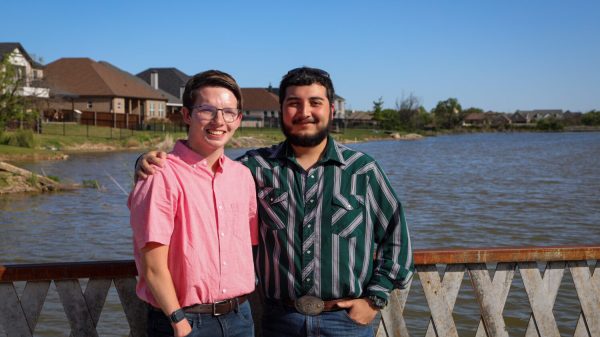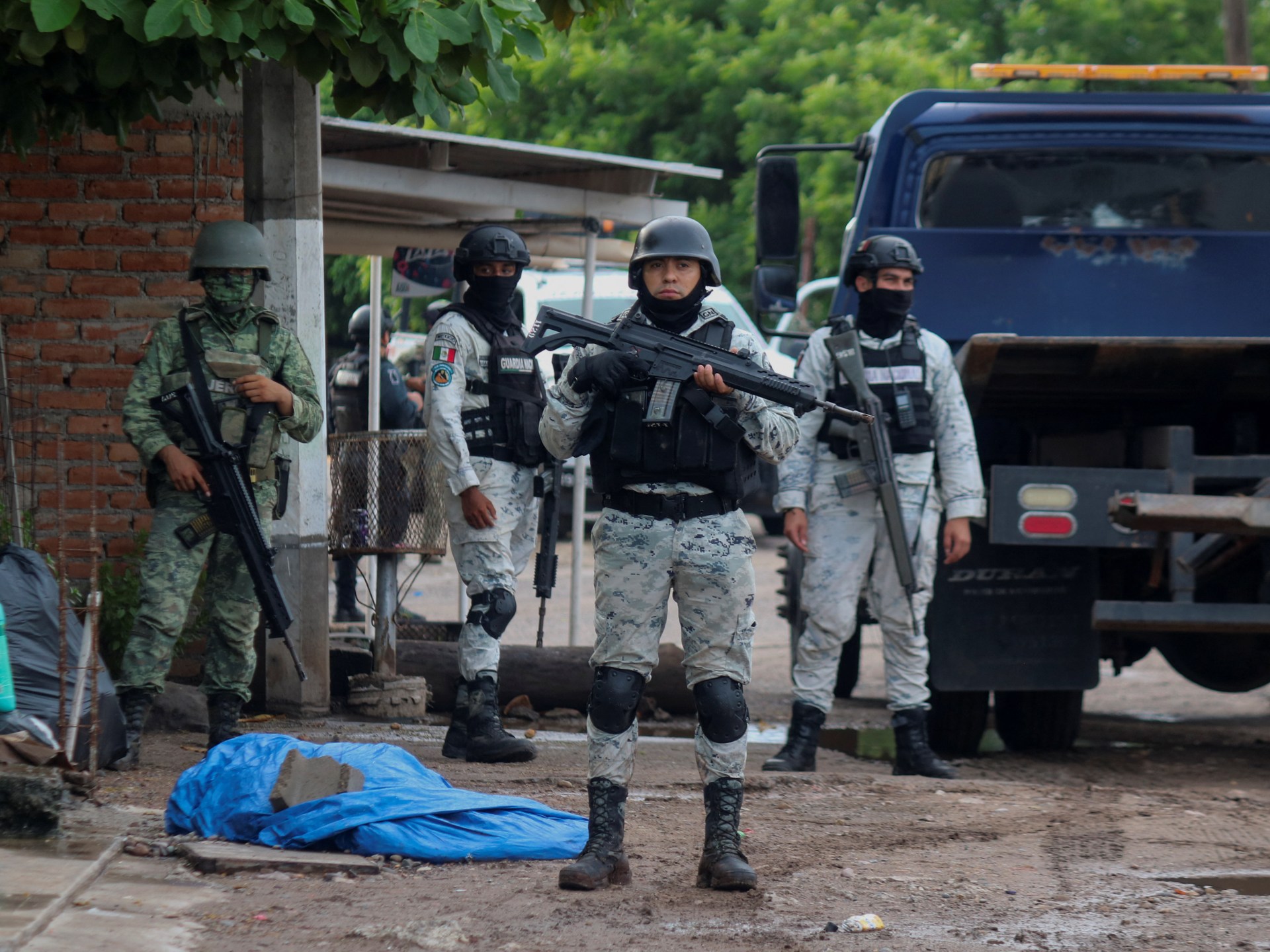Culiacan, Mexico – The man is lying, top off, trousers pulled down, amid the rubbish just off a main road in the capital city of the state of Sinaloa in northwestern Mexico.
It’s late September and he was dumped by a criminal group the night before, another victim of a power struggle that is ripping through Mexico’s Sinaloa drug cartel.
Shootouts in broad daylight, convoys of armed men travelling through the city outskirts, and more than 90 confirmed dead so far have characterised the latest cartel war in one of the most violent countries in the world.
It emerged later that the man was a father who had been walking with his daughter the evening before, when they were stopped and he was taken by a criminal group. His daughter, age five, was left alone on the street until a neighbour found her.
This is the new reality for Culiacan: fear and violence on a daily basis.
More men were dumped the day following, sombreros placed on their heads — a message from whichever faction left them — its meaning, to the uninitiated onlooker, unclear.
One man’s neck hangs at an acute angle. Another has cuts on his face. One more, with terrible bruising on his stomach and ribs.
They’ve been left on the main highway out of Culiacan. Lines of motorists, diverted by police and soldiers at the scene, drive slowly past.
This city has long lived with “narcos” — it’s the epicentre of the powerful Sinaloa cartel, which is “largely responsible” for the massive influx of fentanyl into the United States, according to US authorities.
But it hasn’t seen violence like this for 15 years.
![A crime scene in Culiacan, Mexico, where at least 90 people have been killed in a recent drug cartel war. September 2024. [John Holman/Al Jazeera]](https://www.aljazeera.com/wp-content/uploads/2024/09/WhatsApp-Image-2024-09-26-at-5.39.16-PM-1727387998.jpeg?w=770&resize=770%2C433)
Power vacuum
The latest flareup was caused by a rupture between two powerful factions of the criminal organisation.
It all started on the morning of July 25, according to a letter released by the lawyer of the cartel’s leader, Ismael Zambada Garcia, better known as “El Mayo”.
El Mayo was perhaps the most powerful man in the cartel, especially after the US incarceration of his fellow founder and kingpin Joaquin Guzman Loera, alias “El Chapo”, in 2019.
The letter claims that on that day in July, El Mayo was heading to a meeting with Joaquin Guzman Lopez, El Chapo’s son and a member of the Sinaloa cartel’s younger generation.
The two men were rivals, but El Mayo says that he also trusted Guzman Lopez because he had known him “since he was a young boy”. They had come together at a local events centre, El Mayo’s letter said, to try and help resolve a local political dispute.
At least that’s what he thought.
According to his letter, things quickly took a different turn: “As soon as I set foot inside of that room, I was ambushed. A group of men assaulted me, knocked me to the ground, and placed a dark-colored hood over my head. They tied me up and handcuffed me, then forced me into the bed of a pickup truck.”
El Mayo said he was then driven to an airstrip in rural Sinaloa, surrounded by cornfields.
When Al Jazeera travelled there, cartel lookouts still buzzed around the area.
![The abandoned airstrip in rural Sinaloa, where Ismael Zambada was bundled onto a small plane and flown to the United States. [John Holman/Al Jazeera]](https://www.aljazeera.com/wp-content/uploads/2024/09/Landing-Strip-2_Culiacan-Sinaloa_200924-1727386923.jpg?w=770&resize=770%2C433)
He was bundled onto a small plane, he says. But he wasn’t alone.
Guzman Lopez was the other passenger, and physically restrained him with zip ties. After a short flight, they landed in El Paso, Texas, where US agents were waiting to take both of them into custody.
When El Mayo’s lawyer, Frank Perez, released the letter on August 10, it sent shockwaves through Culiacan.
Many drew the obvious inference: Guzman Lopez had given up El Mayo to make a deal with US authorities for himself, and possibly his brother, Ovidio Guzman Lopez, who is also in US custody.
Several journalists in Culiacan doubt El Mayo’s version of events; specifically that a man who had evaded capture for decades – and who had always been so careful – could have been so easily hoodwinked.
The lawyer for Guzman Lopez denied that his client had made any deal with the US.
But in any case, with El Mayo gone, a power vacuum has opened up, and with talk of betrayal in the air, trouble began to brew in the cartel’s epicentre.

War begins
It took a month and a half for El Mayo’s son, Ismael Zamabada Sicairos – known as “El Mayo Flaco” – to act after his father’s capture.
Reportedly, he was meeting with other groups, trying to get support against the remaining sons of El Chapo in Sinaloa, collectively known as “Los Chapitos”.
On September 9, he must have thought he was ready: The first sign that a war was coming was a radio chat, allegedly, of a commander from the El Mayo faction telling his troops to “send Los Chapitos straight to hell”.
Shortly after, the first shots were fired, and two heavily armed, private armies rumbled into battle.
Videos they have posted show cartel gunmen with tactical vests and heavy weaponry.
Shootouts occurred in the streets, and the dead began to appear: Kidnapped, killed and then dumped, often before dawn.
![More than 3,000 federal police and soldiers have been deployed in Culiacan, Mexico to stem the ongoing drug war. September 2024. [John Holman/Al Jazeera]](https://www.aljazeera.com/wp-content/uploads/2024/09/WhatsApp-Image-2024-09-26-at-5.39.19-PM-1727387810.jpeg?resize=770%2C433)
Federal forces arrived too, with more than 3,000 federal police and soldiers now in Culiacan.
They also look as if they are heading into a warzone: Armoured trucks, police and soldiers covered head to toe in tactical gear, helmets and balaclavas. Nobody wants their identity on display.
Yet despite the police presence, on the streets, the criminal groups are the ones that are ever-present. Lookouts — known in Spanish as “punteros”, men in sunglasses and masks — whiz around on scooters or bikes.
Watching for federal forces or rival groups, they aren’t discreet and make little effort to hide themselves.
Juan Carlos Ayala, a professor at the Autonomous University of Sinaloa specialising in violence and its effects, said that despite their numbers, federal forces are not taking the initiative to fight the groups.
“There are key points, communities, where they know the criminal groups are. They should go and act before things kick off. But there’s no strategy for that,” he said.
“I see a state that’s impotent against organised crime.”

President Andres Manuel Lopez Obrador, who is leaving office in days, has asked the groups “to act responsibly”.
When recently questioned at his daily morning news conference if the US is in some way to blame for the violence in Sinaloa, he responded, “Yes, of course, yes.”
In the past in Mexico, when leaders of criminal organisations have been captured or killed, it has often unleashed bloodshed as those below them fight for the suddenly vacant throne.
As a result, the so-called “kingpin” strategy, first widely used by former President Felipe Calderon has often been questioned.
But Lopez Obrador’s government hasn’t been able to stop organised crime from controlling large swaths of the country – or stemming the violence that accompanies that – during his six years in power.
To many onlookers, the situation in Culiacan looks like a final failure.
‘Traumatic’
Meanwhile, the city has been brought close to a standstill.
With people afraid to venture out at night, many businesses and restaurants are closing early. The local chamber of commerce estimated that in the first two weeks of the crisis, they collectively lost $25m per day.
Restaurant owner Jacobo Quintero is among those that have been affected.
Sitting in his near-empty seafood restaurant, which he built up from a stall to a Culiacan institution, Quintero said he’s worried. “We’ve got about 15 percent of our usual customers,” he said. “People don’t want to come out because there are risks. They’re scared.”
He now closes the restaurant at 4pm to allow his staff time to get the bus home. Transport companies aren’t working after dark.
Across town, it is the same story: Quiet streets and a struggling local economy.
![Many busnesses are closed in Culiacan after a drug war erupted in the Sinaloa cartel. September, 2024. [John Holman/Al Jazeera]](https://www.aljazeera.com/wp-content/uploads/2024/09/Businesses-Closed-5_Culiacan-Sinaloa_190924-1727386747.jpg?w=770&resize=770%2C433)
Many schools are shut too, despite the state government instructing them to open.
Al Jazeera met six-year-old Santiago and his mother Gitzelt in a queue outside of a government welfare office, waiting with hundreds of others for a parcel to keep them going in these times of scarcity. They asked that their last names not be published.
Santiago misses his classes, he said. It was his first trip outdoors since September 9 due to the gunbattles that have raged outside the family’s home. “It was traumatic,” Gitzelt said.
Her son explained the protocol he follows when his mother isn’t home: “I’m with my grandparents and when I hear the shootouts, I have to hide.”
While Santiago, Gitzelt and other residents of Culiacan live with these daily fears, the violence has wrought another – albeit invisible – cost on the city: the people who have disappeared.
Isabel Cruz runs a long-term search group called Warrior Bloodhounds.
In the last two weeks, she has been compiling a list of the latest missing; She said that since the recent violence began, the number of disappeared has rocketed — to even more than those killed.
![Isabel Cruz runs a search group called Warrior Bloodhounds that looks for missing persons in Culiacan, Mexico. [John Holman/Al Jazeera]](https://www.aljazeera.com/wp-content/uploads/2024/09/Isabel-Cruz-5_Office_Culiacan-Sinaloa_230924-1727387564.jpg?w=770&resize=770%2C433)
“I get all types of calls. Desperate families whose relative has just been taken, crying, asking what to do, where to go. Or families who have already gone to the authorities, but they’re told nothing,” she said.
All of those reported missing are placed on the group’s Facebook page, with a photo and the number for Warrior Bloodhounds.
Cruz told Al Jazeera that she has received threats herself to stop publishing information about the missing.
“When I started uploading the files — and there were so many — I started receiving threats, one after another, three threats: That I should stop putting the photos online, that they knew where I lived. But it’s just one more threat against me,” she said.
She refuses to stop. So does the violence.
Andres Villareal contributed to this report.




![Tyson Foods Plant [Photo: Food Manufacturing]](https://southarkansassun.com/wp-content/uploads/2023/08/iStock_1185520857__1_.5e441daa51cca-600x337.jpg)








![Silverado Senior Living Management Inc. [Photo: Los Angeles Times]](https://southarkansassun.com/wp-content/uploads/2023/10/download-6-4-600x337.jpg)

![China's Wuhan Institute of Virology [Photo: Nature]](https://southarkansassun.com/wp-content/uploads/2023/09/d41586-021-01529-3_19239608-600x337.jpg)















